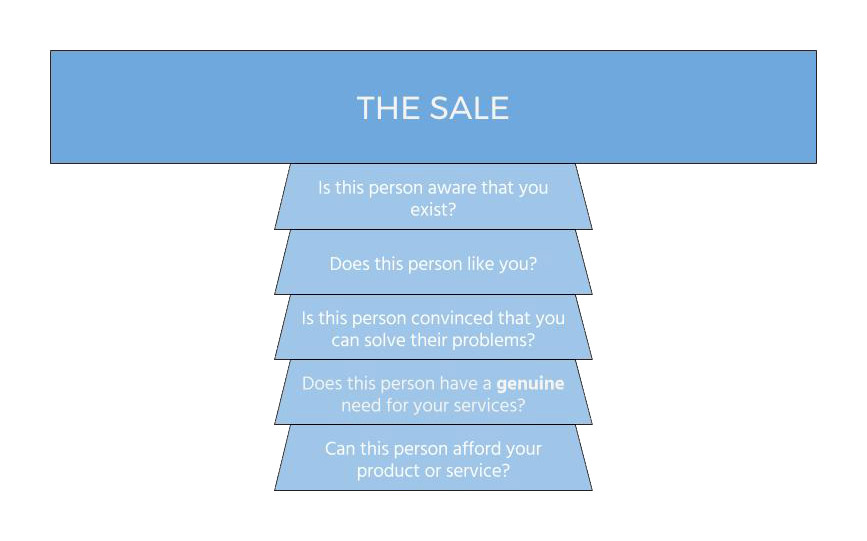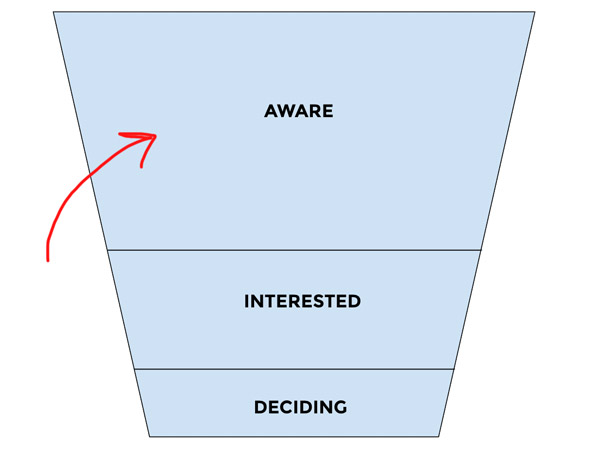Obviously…I’m lying to you.
There’s clearly no single solution to sales that can be applied to every transaction.
But…there is something else: principles. A set of rules that tend to apply to the general act of “purchasing something”. In the next 4 minutes I’m going to explain them, break them down, and hopefully help you sell more of your sweet sweet product or service.
Let’s do this.
First, here are the rules. Each represents a question that you need to ask yourself and each of them must be true for the formula to work:

Notice how the sale is balanced precariously on top of all of them? I want to reiterate that this is a strange formula in which every single question must result in a “yes” before the final value is also a “yes”.
There’s no particular order in which any of these questions need to transform into a “yes”, but they all have to do so at some point.
So that’s it! You can leave now. There’s definitely no more to discuss — have a good one.
….but just in case you have some extra time to kill, let’s take this a little deeper.
Rule #1: Your customers need to have a genuine need for your services.
This is the rule that you have the least control over…or so it would seem at first.
Of course you can’t control people’s thoughts and needs, but here lies the hidden lesson:
You cannot sell solutions to problems that don’t exist and you must define your target market carefully.
If you simply choose to not sell to people that don’t have a genuine need for your services, then you’ve already met the criteria for this goal.
Oftentimes, this rule sorts itself out because you simply don’t end up talking with people that don’t have the problem you’re trying to solve, but I’ve slipped up on this a few times myself.
This is exactly why cold-calling has such a low conversion rate. If you’re badgering people to solve problems that they don’t even have, they’re going to have little patience with you.

Rule #2: Customers need to be ready to solve the problem.
This one is a little more tricky, and it takes many different forms:
- Do they have a budget?
- Are they experiencing an immediate hurdle that is provoking the decision to solve the problem?
- Do they have their leadership staff onboard already?
- Do they feel good today?
- Are they emotionally-bought into the product or service?
It’s quite difficult to get this one right, but it’s all the more important that we do because this rule is really a question of qualification.
The usual result of not getting this question answered early is that you’ll end up wasting a ton of time trying to sell to people, when they’re not even close to making a purchasing decision.
If you’re selling a service, you have to go out of your way to ask questions to probe a little deeper to see if this person is a good match for you.
- Can they afford it?
- When are they planning on starting the project on which you’d be working?
- Are they just looking for quotes right now? Where are they in the buying cycle?
In an ideal world (or if you’re selling a product to mass-markets and conversational selling is not an option), this would fall under the umbrella of better targeting in the first place.
- Don’t target people who can’t afford what you’re selling.
- Nurture potential customers with content relevant to their interested until they’re ready to buy.
- Analyze customer trends to determine when they’re more likely to buy.
Or… just remember this:
Don’t sell to people who aren’t ready to be sold to!
Rule #3: Customers must be convinced (beyond a shadow of a doubt) that you will solve their problem(s).
This is where you really get to go to work.
Most of the traditional sales psychology/seminars/books you’ll find on the internet focus on helping you answer this question, and it’s so damn important that you get this right!
When buying a book…will this book give me what I need? (Entertainment, knowledge, emotion).

When buying a stove…will this cook food thoroughly and efficiently? Will it last me 10 years? Will it explode and destroy my house?
When buying a pair of socks…will these keep my feet warm in climate X? Will they fray after one wash?
…you get the point.
Everyone has their own set of questions that they need answered. You need to answer all of them either through your words or your actions (past or present).
So that leaves you with 2 problems:
- Figure out the set of questions that people have about your product or service; and
- Answer them somewhere (ideally before they talk to you).
Here’s the questions people usually have about the my service (conversion-oriented web design):
- Most Important: Is it worth it? What’s the typical ROI?
- You’ll find that this questions is of paramount importance in the B2B space.
- What will the end result look like?
- Do you have a track record of successes? What does past work look like?
- Are you an expert in this niche? Can I trust you?
- How expensive will it be? Can I afford it?
- How long will it take?
- Do I really need it?
- What can a quality web presence do for my particular business?
- How do I know it will work on mobile phones?
- Will the designer stay with me and help with updates?
- How do updates work?
- How do I rank well on Google?
- Etc…
I’m very careful to answer all of these on my site, and reassure them that they’re making the right decision when I get objections on the phone.
There’s a ton of different ways you can help to show potential customers that you are the right person to solve their problems:
- Relevant Case Studies.
- Customer Testimonials.
- Other kinds of social proof work well here.
- Reviews (from real people).
- A quality brand image/message.
- Speaking engagements.
- Educational videos and content (…not unlike this very blog post 😉 ).
Once you can show people that you are without a shadow of a doubt capable of solving their problems, it starts to get very hard to lose a sale.
Rule #4: Customers must know that you exist.
Let’s suspend reality for a minute and imagine that you have never heard of Apple, Inc…let’s call this fictional company Tangerine, Inc.

Tangerine is not part of your reality — you’re not even remotely aware that they exist. Can you think of a way that they could stay in business?
When you don’t advertise, you slowly become a Tangerine. You do not make any sales if people are not aware that you exist.
Highway billboard advertisements used to really confuse me. Why do they exist? I’m obviously not going to make a transaction right now while I’m driving. Who looks at say, a local plumber’s billboard, and picks up their phone to call them while driving?
When you don’t advertise, you slowly become a Tangerine.
Obviously nobody does that…but the business of highway billboard advertising is absolutely massive. Why? Because companies are using them to pay a tax (in a way) to stay relevant. They don’t want to become a Tangerine, so they invest millions of dollars into the awareness campaigns that get you to know that they exist.
It’s in many ways the first step in the buying cycle, but here’s the takeaway: it’s not that people won’t buy from you if they’re not aware of your business, but rather that they simply can’t.

It’s important that you solve this problem for your target customers. If you’re really right for them, then they deserve to know that you exist!
Rule #5: Customers need to like you (or your brand).
Finally, and perhaps most controversially, you need to make sure that your customer likes you.
You’re looking to exchange goods/services for money. But…where is the money?
I’m not talking physically (who knows where your really is money is, that’s a totally different discussion), but rather more conceptually.
The answer is that it resides in the bank accounts, the hands, and the mattresses of real people. Real people who have emotions and strong feelings about other people…especially you.
If your customer isn’t emotionally bought into your brand (or you, if you’re taking a more direct sales approach), you can kiss any sales opportunity you had goodbye.
So…how do you get people to like you?
I’d be doing you a disservice if I even tried to answer that in a single blog post, but Dale Carnegie has some of the best documentation on the practice of getting people to like you that I’ve ever encountered. That’s a good place to start.
This is why branding is so important — getting people to buy into you emotionally is a key part of any sale. Neglecting this rule puts you in the camp of business owners that people only do business with out of necessity: certain airlines and financial institutions come to mind.
You don’t want to be in that camp if you can help it.
An Example: The “Un-Tangerine”.
Alright, we’ve been floating around in the abstract for quite a while now — let’s tie it all together with a tangible, real-life example.
Let’s look at one of the most successful branding case studies of all time.
Apple is unique in that they’re solving a compound set of problems. For the sake of simplicity, we’ll focus on the iPhone market.
What problem are they solving? Again this is a compound problem:
- People need access to information.
- People want to be entertained.
- People need to be able to communicate with the rest of the world.
- People want to feel “cool” and “connected”.
- Obviously, Apple products are the more expensive mobile provider, but customers still pay that premium because of this problem.
Rule #1: Do people have a genuine need for Apple products?
This is like asking if people genuinely want to have mobile phones. It’s such a revolutionary piece of technology that it’s really hard to live without one nowadays, so the need is obviously very real.
Rule #2: Are people ready for Apple to solve their problems?
Again, this is a question of qualification. Not everyone is bought into Apple’s brand and pricing model, but that’s simply because they’re targeting a very specific kind of person.
Apple is very careful to target only those people by gating their products with their pricing, and crafting a very particular premium brand around them.
Rule #3: Are people convinced that Apple will solve their problems?
Apple is unique in that they were a forerunner for a revolutionary piece of technology. It put them in a position of authority from the inception of modern mobile phones, so they don’t really need to try to convince people that they can solve their problems anymore.
This is why the Apple brand is so valuable: it’s so ubiquitous and dripping with authority that they don’t ever need to worry about Rule 3 (at least for the next decade).
Apple is the “company that provides quality modern mobile phones”. There are very few brands in the world with this kind of leverage in their market.
Rule #4: Are people aware of Apple products?
I’m not going to waste your time here: Apple is backed by a massive marketing machine. Everyone in the Western world knows who they are and what they’re about.
Rule #5: Do people like Apple’s brand?
Debatably, yes. Although this is a very polarizing question, it’s hard to say that people don’t feel comfortable and trust the brand from both sides of the argument.
The important thing to remember here is that Apple has chosen to adhere to a certain message in their branding (premium, quality, simplicity), and that message obviously appeals to their target demographic.
Tying it all together…
I like to make things very actionable. So, here’s how you can get the most value from this post: complete the exercise for your business.
Get the “5 Sales Rules” Workbook.
I’ve compiled a workbook that will help to guide you through the process of making sure your business sticks to the 5 sales rules, and it’s all yours.
Download as PDFThat’s it for now, but let me know in the comments below if this makes sense to you. I talk to 10-20 business owners every week, so I want to make sure that this was articulated clearly.
Take care folks — I hope I’ll be seeing your shiny products distracting me from driving on the highway soon enough.